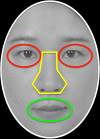Self-Construal Priming Affects Holistic Face Processing and Race Categorization, but Not Face Recognition
- PMID: 31507505
- PMCID: PMC6718463
- DOI: 10.3389/fpsyg.2019.01973
Self-Construal Priming Affects Holistic Face Processing and Race Categorization, but Not Face Recognition
Abstract
Self-construal priming can affect an individual's cognitive processing. Participants who were primed with interdependent self-construal showed more holistic process bias than those who were primed with independent self-construal. The holistic processing of a face also differs across cultures. As such, the purpose of the present study was to explore whether the cultural differences in holistic face processing can be interpreted from the perspective of self-construal, as well as to investigate the relationship between self-construal and holistic face processing/face recognition/race categorization. In Experiment 1, participants were primed with control, interdependent, or independent self-construal, respectively, and then they completed a feature-space same-different task (Experiment 1A) or a composite face effect task (Experiment 1B). Results showed no priming effect in Experiment 1A, whereas independent self-construal priming resulted in less holistic processing in Experiment 1B. In Experiment 2, participants were primed with control, collective/interdependent, relational, or independent self-construal, respectively, and then they completed a Vanderbilt Holistic Face Processing Test and Cambridge Face Memory Test. Participants who were primed as independent showed greater congruency effect than the relational group. Self-construal priming had no effect on face recognition. In Experiment 3, we manipulated self-construal in the same way as that in Experiment 2 and monitored the eye movement of Chinese participants while they learned, recognized, and categorized their own-/other-race faces. Self-construal priming had no effect on face recognition. Compared with other groups, collective-/interdependent-self priming increased the fixation time of eyes and decreased the fixation time of nose in the race categorization task. These results indicated that the cultural differences in self-construal could not mirror the cultural differences in face processing in a simple way.
Keywords: composite face effect; face recognition; holistic processing; race; self-construal priming.
Figures










Similar articles
-
Cultural Differences in Face Recognition and Potential Underlying Mechanisms.Front Psychol. 2021 Apr 13;12:627026. doi: 10.3389/fpsyg.2021.627026. eCollection 2021. Front Psychol. 2021. PMID: 33927668 Free PMC article. Review.
-
Self-Construal Priming Modulates Ensemble Perception of Multiple-Face Identities.Front Psychol. 2019 May 16;10:1096. doi: 10.3389/fpsyg.2019.01096. eCollection 2019. Front Psychol. 2019. PMID: 31156512 Free PMC article.
-
The hows and whys of face processing: Level of construal influences the holistic processing of human faces.J Exp Psychol Gen. 2015 Dec;144(6):1037-41. doi: 10.1037/xge0000112. Epub 2015 Oct 5. J Exp Psychol Gen. 2015. PMID: 26436426
-
Bicultural Minds: A Cultural Priming Approach to the Self-Bias Effect.Behav Sci (Basel). 2022 Feb 11;12(2):45. doi: 10.3390/bs12020045. Behav Sci (Basel). 2022. PMID: 35200296 Free PMC article.
-
The "parts and wholes" of face recognition: A review of the literature.Q J Exp Psychol (Hove). 2016 Oct;69(10):1876-89. doi: 10.1080/17470218.2016.1146780. Epub 2016 Mar 4. Q J Exp Psychol (Hove). 2016. PMID: 26886495 Free PMC article. Review.
Cited by
-
Does self-construal shape automatic social attention?PLoS One. 2021 Feb 10;16(2):e0246577. doi: 10.1371/journal.pone.0246577. eCollection 2021. PLoS One. 2021. PMID: 33566804 Free PMC article.
-
Cultural Differences in Face Recognition and Potential Underlying Mechanisms.Front Psychol. 2021 Apr 13;12:627026. doi: 10.3389/fpsyg.2021.627026. eCollection 2021. Front Psychol. 2021. PMID: 33927668 Free PMC article. Review.
-
Differences in eye movements for face recognition between Canadian and Chinese participants are not modulated by social orientation.PLoS One. 2023 Dec 14;18(12):e0295256. doi: 10.1371/journal.pone.0295256. eCollection 2023. PLoS One. 2023. PMID: 38096320 Free PMC article.
References
-
- Brewer M. B., Gardner W. (1996). Who is this “we”? Levels of collective identity and self-representations. J. Pers. Soc. Psychol. 71, 83–93. 10.1037/0022-3514.71.1.83 - DOI
LinkOut - more resources
Full Text Sources
Research Materials

